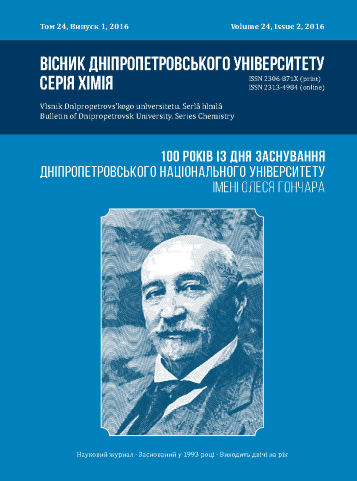The complexes structures of chromium(III) with ethylglycine and alanine
DOI:
https://doi.org/10.15421/081611Keywords:
Сhromium, complex connections, amino acids, аlanine, ethylglycineAbstract
The reaction of chromium(III) chloride with the amino acid ethylglycine in a 1:1 molar ratio of metal to ligand has been performed. The complex with monodentate coordinated ethylglycine [Cr(CH3СН2CH(NH3)COO)(H2O)3Cl2]Cl∙3H2O (І) has been synthesized. Interaction of compound (І) with the α-аlanine results in formation of different-ligand complex [Cr(CH3СН2CH(NH3)COO)(СН3CH(NH3)COO)(H2O)3Cl]Cl2 (ІІ). The complexes I and II have been analyzed by IR and UV/Vis spectroscopy. Significant difference in wave numbers of carboxylic group valence vibritations (nas(COO–)–νs(COO–)=220 cm–1 for (I) and nas(COO–)–ν s(COO–)=244 cm–1 for (II))confirms that both amino aсids are coordinated to Cr3+ by oxygen of carboxyl group. Compounds (І–ІІ) have the octahedral structure. Two bands of transition (4Т1g¬4A2g and4Т2g¬4A2g) have been observed in the visible part of the spectrum and one band of transition (4Т1g(Р¬4A2g in UV region. The parameters of crystal field of complexes have been calculated (Dq = 1640 cm–1, В= 627 cm–1 and b = 0.61 for (I) and Dq = 1700 cm–1 В= 553 cm–1 and b = 0.54 for (IІ)). The computer three-dimension models of complexes (II) has been created. Geometrical parameters of complexes have been calculated at HF/6-31G(D) level of theory.References
Vincent, J. B. (2010). Chromium: celebrating 50 years as an essential element?. Dalton Trans., 39(16), 3787–3794. doi:10.1039/b920480f CrossRef
Mertz, W. (1993). Chromium in human nutrition: a review. J. Nutr., 123(4), 626–633.
Cooper, J. A., Blackwell, L. F., & Buckley, P. D. (1984). Chromium(III) complexes and their relationship to the glucose tolerance factor. Part II. Structure and biological activity of amino acid complexes. Inorg. Chim. Acta., 92(1), 23–31. doi:10.1016/S0020-1693(00)80060-2 CrossRef
Kegley, E. B., Spears, J. W., & Eisemann, J. H. (1997). Performance and glucose metabolism in calves fed a chromium-nicotinic acid complex or chromium chloride. J. Dairy Sci., 80(8), 1744–1750. doi:10.3168/jds.S0022-0302(97)76107-1 CrossRef
Vaidyanathan, V. G., Asthana, Ya., & Nair, B. U. (2013). Importance of ligand structure in DNA/protein binding, mutagenicity, excision repair and nutritional aspects of chromium(III) complexe. Dalton Trans. 42, 2337-2346. doi:10.1039/c2dt32124f CrossRef
Mowat, D. N., Chang, X., & Yang, W. Z. (1993). Chelated chromium for stressed feeder calves. Can. J. Anim. Sci., 73(1), 49–55. doi:10.4141/cjas93-004 CrossRef
Hayirli, A., Bremmer, D. R., Bertics, S. J., Socha, M. T., & Grummer, R. R. (2001). Effect of chromium supplementation on production and metabolic parameters in periparturient dairy cows. J. Dairy Sci., 84(5), 1218–1230. doi:10.3168/jds.S0022-0302(01)74583-3 CrossRef
Zhitkovich, A., Voitkun, V., & Costa, M. (1995). Glutathione and free amino acids form stable complexes with DNA following exposure of intact mammalian cells to chromate. Carcinogenesis, 16(4), 907-913. doi:10.1093/carcin/16.4.907 CrossRef
Staniek, H., Krejpcio, Z., Iwanik, K., Szymusiak, H., & Wieczorek, D. (2011). Evaluation of the acute oral toxicity class of trinuclear chromium(III) glycinate complex in rat. Biol. Trace Elem. Res., 143(3), 1564-1575. doi:10.1007/s12011-011-8959-3 CrossRef
Maciejewska, G., Cieślak-Golonka, M., Staszak, Z., & Szeląg, A. (2002). Homo-and hetero-nuclear chromium(III) complexes with natural ligands. Part 1. Spectroscopic and mass spectra studies on ternary [M–L1–L2] systems]. Transition Met. Chem., 27(5), 473-480. doi:10.1023/A:1015604410186 CrossRef
Chernushenko, L. A., & Kislicina, A. B. (2013). [The structures of comlexes chromium(III) with cystine and rthylglycine]. Visnik Dnipropetrovsʹkogo universitetu Seria Himia, 21(20 (3/1)), 49-54 (in Russian). doi:10.15421/081318 CrossRef
Chernushenko, L. A., & Bezugla, A. (2012). [Electronic spectra of complexes of chromium(III)]. Bulletin of Dnipropetrovsk University Series Chemistry, 20(18), 124-126 (in Russian). Retrieved from nbuv.gov.ua
Chernushenko, L. A., Vinichenko, I. G., & Zegzhda, G. D. (1998). [Complexes of chromium (III) with monodentate coordinated cysteine]. Ukr. Chem. J. 64(6), 77-81 (in Russian).
Marai, H., Kita E., Kiersikowska, E., Kuchta, S., Bajek, A., & Drewa, T. (2012). Kinetic studies on H+-catalysed aquation of chromium(III)-oxalato-asparaginato and chromium(III)-oxalato-histidinato complexes. Transition Met. Chem. 37(2), 337-344. doi:10.1007/s11243-012-9594-3 CrossRef
Drago, R. (1967). [Physical methods in inorganic chemistry], Moskow, Russian Federation: Mir.
Nakamoto, K. (1991). [Infrared and Raman Spectra of Inorganic and Coordination Compounds]. Moskow, Russian Federation: Mir.
Velichko, L. V., Golenko A. A., & Shtemenko A. V. (2012). [Complexes of dirhenium(III) with 3-amino-1-adamantantcarboxylic acid]. Ukr. Chem. J., 78(3), 20-24 (in Russian).
Sharma, R. K., Tiwari, B., & Tomar, J. S. (2013) Synthesis and characterization of CNTs using egg albumin & Metal (Cr+3). Int. J. Adv. Res. Sci. Technol. 2(1), 27-29. Retrieved from www.ijarst.com
Budiasih, K. S., Anwar, C., Santosa, S. J., & Ismail, H. (2015). Development of the Synthesis of Chromium and Molybdenum – Amino acid Complexes: A Green Chemistry Approach. Adv. Mater. Res. 1101, 276–279. doi:10.4028/www.scientific.net/AMR.1101.276 CrossRef
Arstamyan, J. M., & Mkrtchyan, K. (2006). [Extraction-definition absorptiometric acridine yellow chromium in natural and waste waters]. Chem. J. Armenia, 59(3), 39–43 (in Russian).
Downloads
Published
Issue
Section
License
Copyright (c) 2016 Oles Honchar Dnipropetrovsk National University

This work is licensed under a Creative Commons Attribution 4.0 International License.
- Authors reserve the right of attribution for the submitted manuscript, while transferring to the Journal the right to publish the article under the Creative Commons Attribution License. This license allows free distribution of the published work under the condition of proper attribution of the original authors and the initial publication source (i.e. the Journal)
- Authors have the right to enter into separate agreements for additional non-exclusive distribution of the work in the form it was published in the Journal (such as publishing the article on the institutional website or as a part of a monograph), provided the original publication in this Journal is properly referenced
- The Journal allows and encourages online publication of the manuscripts (such as on personal web pages), even when such a manuscript is still under editorial consideration, since it allows for a productive scientific discussion and better citation dynamics (see The Effect of Open Access).


